







































20 THINKING SMALL Students are building small houses in Moscow to address statewide affordable housing issues.
06
Students get first-hand experience building houses from start to finish in a collaboration between U of I and the Moscow community.
28
OFF EVICTIONS
College of Law students are preventing evictions and keeping people in their homes.
12
THE WATER WAY
A collaborative partnership in Coeur d’Alene preserves lake health, protects water quality and educates the next generation.
14
ROBOTICS AND LIFE AFTER STROKE
A new tool, developed in Engineering, helps stroke patients in their recovery.
26
SMOKY HITCHHIKERS
A professor pioneered a new science that explores the ecological effects of microbes traveling in wildfire smoke.
A SWIMMING SUCCESS
Students worked with Nike to design suits for girls and women with an eye on inclusivity.
32
THE LEADERSHIP PIPELINE
The West Ada Principal Cohort is training the next leaders of Idaho school districts.
34
CREATING VALUE FROM WASTE
A global team is forging a sustainable future for the dairy industry. STUDENT SUCCESS STORIES
09 Victor Zhong
18 Bishal Thapa
23 Keera Paull
31 Grace Meyer
Ioften refer to the University of Idaho as a university on the rise. We bolstered our enrollment, reached ambitious fundraising goals, supported students at unprecedented levels and opened facilities that transformed our campus.

We’re now positioned to invest in our future and redouble our efforts to support students and faculty in addressing challenges that face our state and our world. This issue of Here We Have Idaho features Vandals making a difference in communities small and large across the state.
College of Law students in Boise took on complex legal work to assist neighbors facing eviction. In Moscow, several College of Art and Architecture students designed and built an affordable house in collaboration with the Moscow Affordable Housing Trust and a generous U of I alumnus. The burgeoning West Ada School District identified a need for more administrators and worked with the U of I to develop a pipeline for principals.
The vision for the Center for Agriculture, Food and the Environment is embodied in interdisciplinary research on soil and water by U of I graduate students. And the Community Water Resource Center brings numerous partners together to tackle lake health and water quality in Coeur d’Alene.
These stories and others in the following pages embody the pillars of our Brave. Bold. Unstoppable. campaign: student success, sustainable solutions and supporting a thriving Idaho. We officially launch the second phase of our campaign this month, and we’re well on our way to our ultimate fundraising goal of $500 million by 2025.
Thank you for investing in our university.
Go Vandals!
C. Scott Green ’84 President
The University of Idaho Magazine
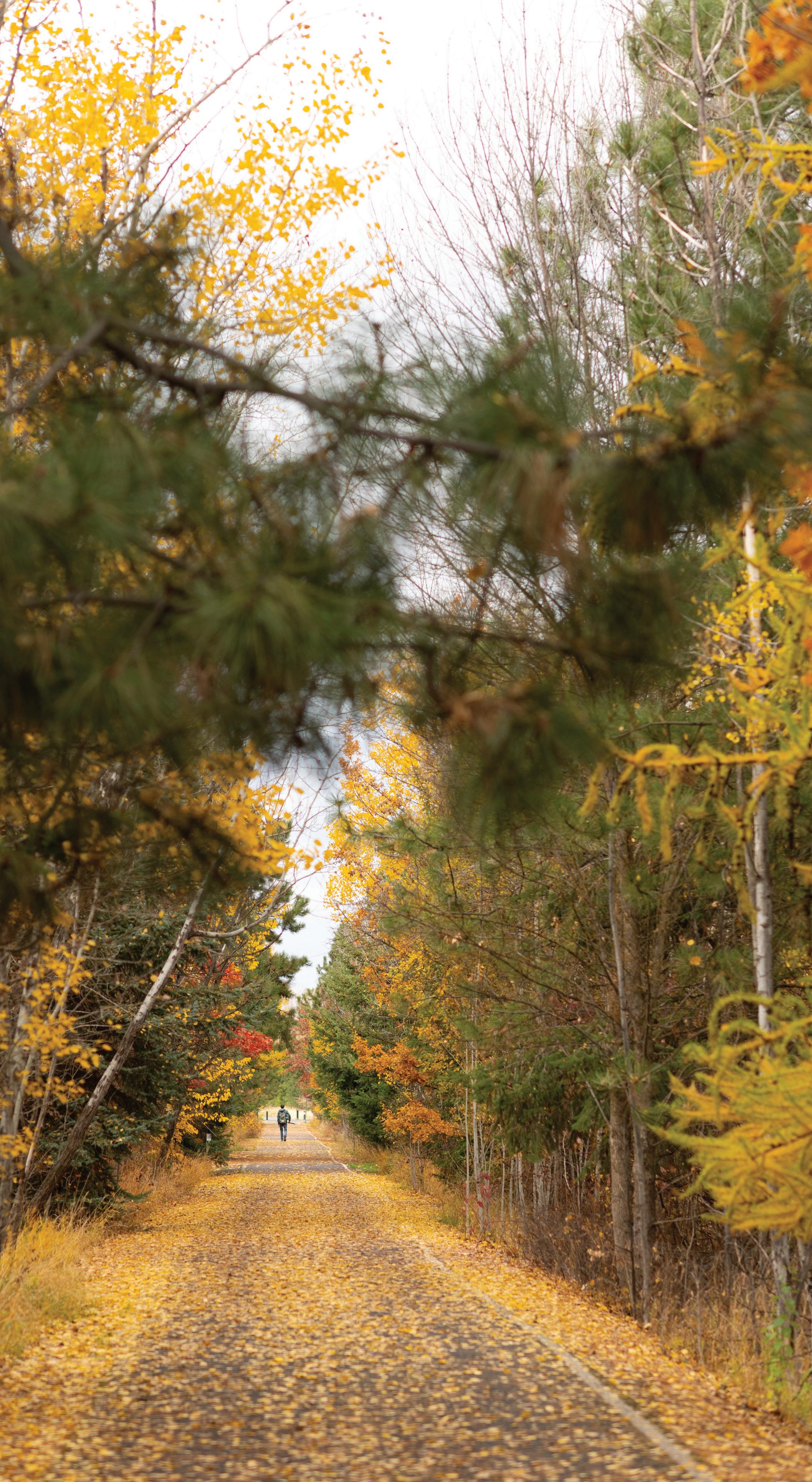
Fall ’22
President C. Scott Green ’84
Vice President for Advancement
Mary Kay McFadden ’80
Chief Marketing Officer
John Barnhart
Executive Director for University
Communications
Jodi Walker
Executive Director, U of I Alumni
Association
Amy Lientz ’95
Alumni Association President
Nick Weber ’02
University of Idaho Foundation Chair
Craig Olson ’74
Managing Editor
Jodi Walker
Layout/Production
Creative Services
Copy Editor
Jennifer Bauer ’98
Writers and Contributors
Ralph Bartholdt
Amy Calabretta ’03
David Jackson ’92
Katie Marshall
John O’Connell
Kyle Pfannenstiel ’20
Alexiss Turner ’09
Photography
Idaho Visual Productions
Melissa Hartley
Andrew Botterbusch ’21
Garrett Britton
Joe Pallen ’96
For detailed information about federal funding for programs mentioned in this magazine, see the online version of the relevant story at uidaho.edu/magazine.
The University of Idaho is an equal opportunity, affirmative action employer and educational institution.
© 2022, University of Idaho
Here We Have Idaho magazine is published twice per year. The magazine is free to alumni and friends of the university. University of Idaho has a policy of sending one magazine per address. To update your address, visit uidaho.edu/alumni/stay-connected or email alumni@uidaho.edu. Contact the editor at UIdahoMagazine@uidaho.edu.
2,262

Nearly One Hundred alumni events coming up. Update your contact info and don’t miss out.
uidaho.edu/alumni-update

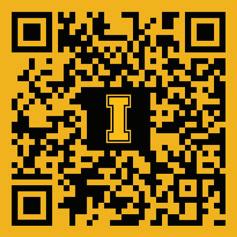




U of I launches its first
Degrees awarded in Spring 2022. CANDY BAR in 2022.



Votes tallied to select the official Vandal Tartan, registered with the Scottish Register of Tartans.














8






U of I engineering students and graduates traveled to Kennedy Space Center to witness the SpaceX launch, sending their research to the International Space Station.

A year-long celebration of Title IX honors women’s influence in athletics and inclusion in academics.

400,000
Seedlings produced annually by U of I’s Franklin H. Pitkin Forest Nursery, one of two university forest nurseries in the U.S.
U of I ranked Top Value in the West for three years in a row by U.S. News and World Report.
MARCH 23
U of I was the first university in the state to introduce robot food delivery service.

One Million
The Micron Foundation committed $1 million to promote greater diversity in engineering in Idaho.

$728,000
Dollars raised on Vandal Giving Day 2022, a new record. Thank you.
GIVING DAY VANDAL
APRIL 6-7, 2021
$1 Million
$600,000 National Science Foundation funding for U of I researchers to examine the impacts of climate change on tick-borne diseases.
Donated by Chobani to U of I’s Center for Agriculture, Food and the Environment to help build the nation’s largest research dairy.

 By Kyle Pfannenstiel ’20
By Kyle Pfannenstiel ’20
For more than a year, a half dozen University of Idaho College of Law students in Boise prevented evictions one-by-one, keeping more people in their homes in one of the nation’s least affordable housing markets.
Launched as the national eviction moratorium ended, U of I’s legal aid Housing Clinic helped more than 100 nearby households. Clinic students advocate for tenants who are often underrepresented in eviction proceedings. The nonprofit Jesse Tree is focused on homeless prevention and provides funds to pay back rent to settle certain cases.
Together, the partnership continues to provide first-of-its-kind legal aid across the Treasure Valley.
“Landlords are getting what they need — rent. And people aren’t being kicked out,” said Ashley Ahlquist, a Louisiana State University law graduate who participated in U of I’s clinic as a visiting student. “It is much more expensive for landlords and tenants — both of them — to move a tenant out and find a new one.”
Clients were largely able to stay in their homes until the end of their lease, or even longer with the help of the mediation and rent assistance offered by the partnership. Clinic leaders call their efforts a success, pointing to individual stories of client trauma and triumph to showcase the necessity of aid work.

The U of I College of Law housing clinic began August 2021, when the U.S. Supreme Court rejected the Centers for Disease Control and Prevention’s eviction ban. The CDC argued evictions could be detrimental to public health amid the COVID-19 pandemic, but the Court ruled the health agency had exceeded its authority.
Despite legal turmoil over restrictions, the need for homeless prevention work was clear in Idaho’s most populous, fastestgrowing region.
“We have minor growth in our wages in this valley, but we have this incredible growth in the cost of rent,” said U of I Law Professor Jason Dykstra, who directs the housing clinic.
For some Idaho renters, the economic squeeze resulted in months of unpaid rent. Jesse Tree Eviction Court Program Manager Morgan DeCarl knows the results can be traumatic.
“Even when we’re not talking about the difference between being housed or not, having an eviction on your record is honestly kind of like a death sentence in this market,” she said.
Jesse Tree is the only Idaho agency that offers in-court support services for evictions, DeCarl said. The nonprofit is one of a handful like it in the U.S.
The eviction prevention work done by the clinic ripples through the community in positive ways, Dykstra said. People facing eviction are “on the cusp of homelessness,” he said. If more people can stay housed, then “they’re much more likely to be able to hold a job and avoid homelessness,” Dykstra said. He recalls one client, a victim of domestic violence, being evicted after her alleged abuser was arrested for violating a crimefree lease provision. After U of I law clinic students explained the planned eviction would likely violate the federal Fair Housing Act, the landlord agreed to not enforce the provision.
That case, like many, came down to the wire. “There was literally a day where, had we not reached an agreement, she would have been homeless that night,” Dykstra said.
The housing clinic also helped Yadira Nunez, 33, a single mother of five children, avoid homelessness for a while. Her landlords
accused her of breaching her lease for various reasons in late 2021, while she was out of work. She felt like they wanted to sell the mobile home she rented.
Nunez didn’t have enough money to find a new place, after recently paying off her deposit. So, she called the law clinic.
Jesse Tree paid thousands of dollars in rent to help Nunez, and the clinic students’ efforts allowed her to stay in the mobile home until her lease ended.
“If I wouldn’t have sought their help, they would have kicked me out and I would have an eviction on my record,” Nunez said.
After her lease ended, Nunez said she struggled to rent another house. For nearly two months, Nunez lived in her car while her children stayed with their father. In June, she moved her family into a home again.

U of I’s housing aid work drew praise from the White House and Department of Justice, along with 99 law schools who responded to Attorney General Merrick Garland’s call for eviction prevention help. The broader push helped over 10,000 households in the first five months, according to one survey by Georgetown University Law Center and New York University School of Law.
In eviction mediation, the stakes are high. A decision — often handed down within days — could leave someone homeless. Ahlquist stays patient.
“Even me as a law student in this clinic, reading these things — it can be confusing. And I know the law,” she said. “So, I can’t imagine how scary it is for people who don’t understand what’s going on.”
Ahlquist recalls a case in which a landlord wanted a woman with two children out of the
apartment within two weeks, even with Jesse Tree funds to repay unpaid rent. The client avoided an eviction on her record, but still had to leave.
As Ahlquist explained the situation, she heard the client crying on the phone.
That was a first for her.
When Ahlquist hung up, she cried.
“This is work to me, but on the other end of the phone is someone’s literal life,” Ahlquist said.
After a successful first year, U of I plans to continue the housing clinic 2023.

This is work to me, but on the other end of the phone is someone’s literal life.
– Ashley Ahlquist
Victor Zhong, a senior and first-generation student whose undergraduate research explores virus-infected pathogens’ impact on humans. Professor Paul Rowley calls Victor, “a vital part of my team.”

I always liked science when I was little. I always wanted to use science to make a difference, to contribute something to solve problems and not wait for others to solve them.
The University of Idaho Center for Secure and Dependable Systems this year was appointed academic support center lead for the newly launched Department of Defense University Consortium for Cybersecurity (UC2).
This national positioning expands opportunities for students and faculty to engage in cybersecurity solutions needed in the highest levels of government.
The congressionally mandated UC2 exists to facilitate two-way communication between the U.S. Secretary of Defense and academia across the United States. As one of the National Security Agency’s first National Centers of Academic Excellence in Cyber Defense Education, U of I’s role is to communicate with other nationally recognized centers, a community of 340 schools nationwide.
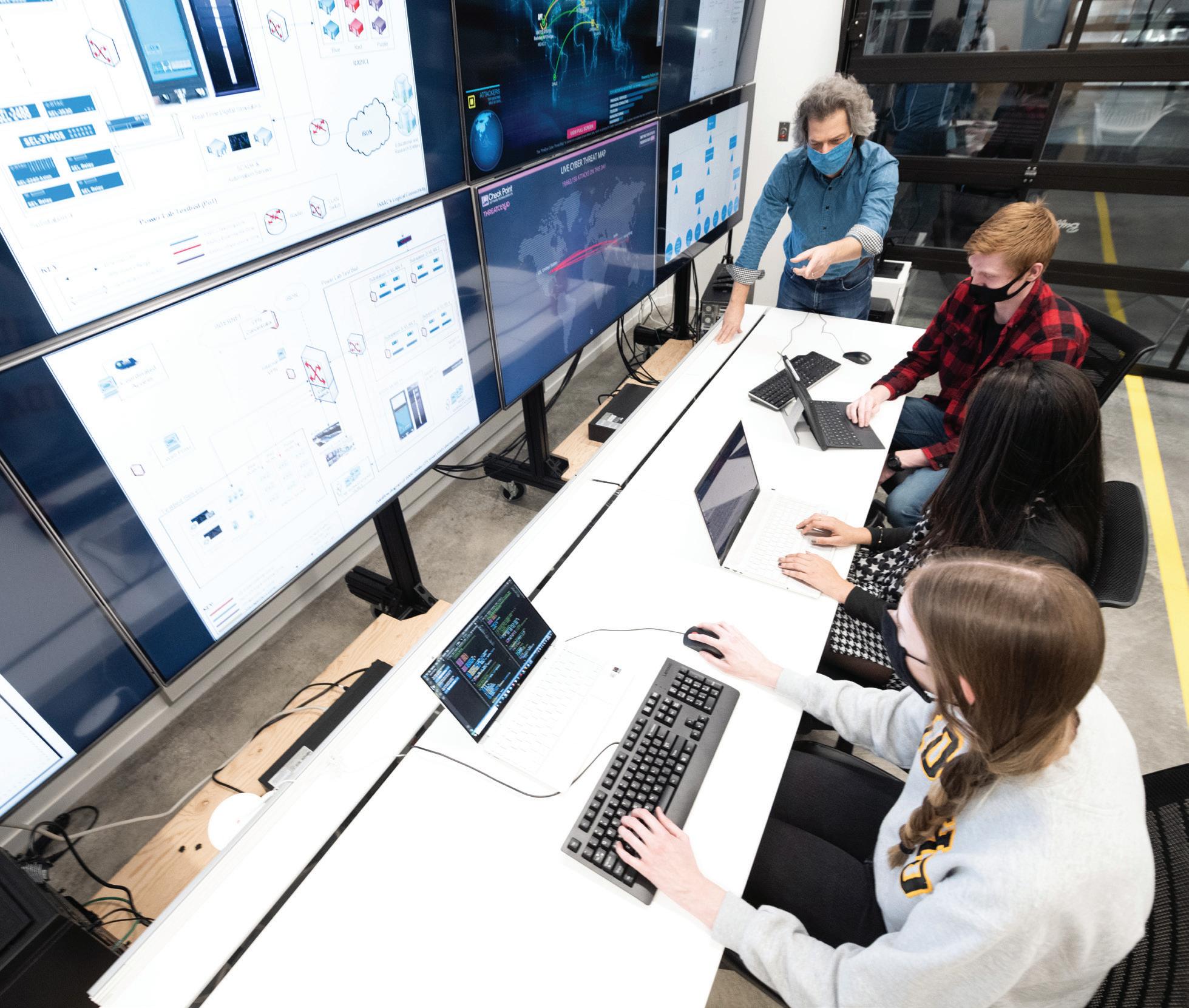
Ranches across the American West could make their grazing practices more sustainable using a virtual fence system being developed through a joint University of Idaho project.
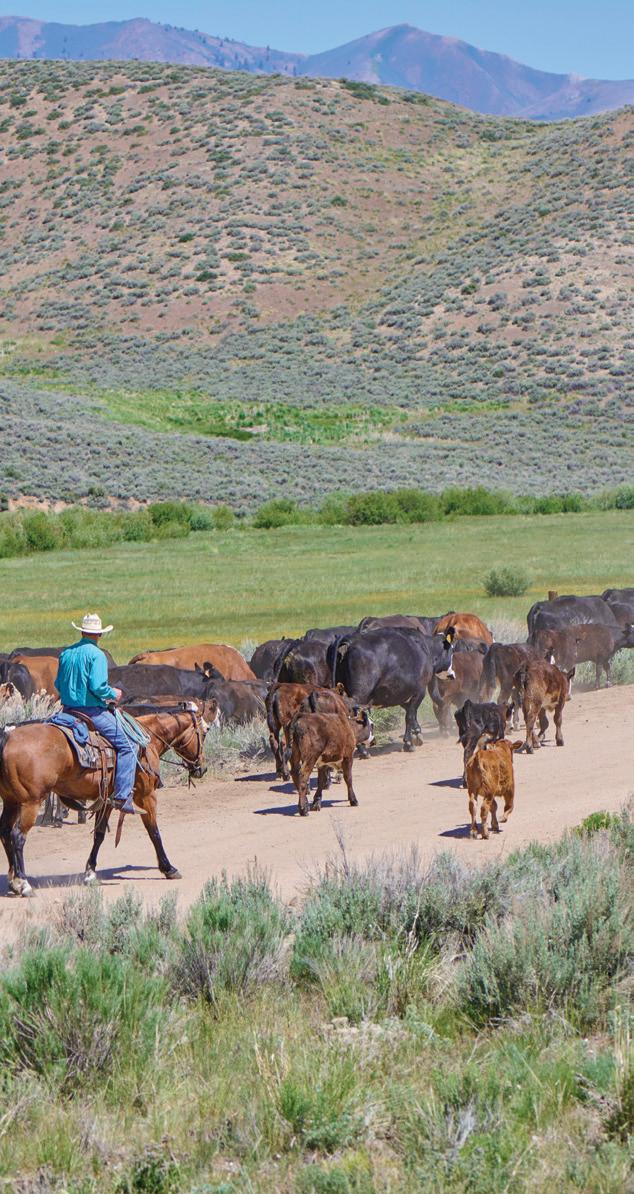
Newly awarded federal funding kickstarted a four-year field project for researchers at U of I and Washington State University to test the safety and efficacy of a prototype virtual fence system to manage cows, sheep and other grazing livestock with minimal ecological footprint.
Physical barriers disrupt wildlife migration and fragment habitats. The new technology aims to provide a low-cost tool that performs reliably in mountainous western states, where existing virtual systems struggle to provide reliable GPS data. The new system uses proximity sensing technology that functions in mountainous terrain.
Dozens of K-12 teachers in ancestral tribal homelands will work directly with tribal leadership and University of Idaho researchers to incorporate Indigenous knowledge and practice into K-12 STEM curriculum.

U of I will collaborate with tribal nations to build and deliver a new professional development program called Cultivating Relationships. A $3 million grant from the National Science Foundation is helping researchers test the model in regions of the western U.S. and tribal nations starting summer 2023.
Past research has shown STEM lessons ignore Indigenous principles that shaped thousands of years of sustainable land management practices. By centering Indigenous lessons and relationships with land in K-12 lesson planning, the project seeks to bridge the long-standing disconnect in American classrooms. Teachers enrolling in the certification program will be immersed in experiential learning of Indigenous approaches to scientific fields and land management. Project results will be shared with tribal education leaders, community members and researchers.

 By Katie Marshall
By Katie Marshall
Where there is water in North Idaho, Vandals find a way — a way to educate, a way to recreate and a way to advocate. Leading the charge and creating connections among the area’s water issues is the Community Water Resource Center (CWRC) at University of Idaho Coeur d’Alene. It’s a model of collaboration and education that can leave a lasting mark on the people and landscape of the Gem State. From ski resorts to lakeshores, the area’s economy depends on the recreation water provides. Meanwhile, contamination from mining and rapid population growth present concerns for the health and future of this water. The U of I Center team tapped into statewide university expertise, local leaders and community members to establish the CWRC about ten years ago. Its four major focus areas include The Confluence Project, Bay Watchers, Stormwater and Erosion Education Program (SEEP) and the Our Gem Collaborative.

“One of the best things about the CWRC is that we have such diverse programs we’re able to reach a wide variety of people,” said Marie Schmidt ’09, ’12, CWRC outreach specialist.
Each program is made possible through partnerships with local and regional groups including school districts, the Coeur d’Alene Tribe, ski resorts, the Department of Environmental Quality, UI Extension, the health district and others.
“The CWRC has been the most important connection I have ever made between my classroom and the community,” said Jamie Esler ’16, Lake City High School and U of I dual credit teacher. “They’ve designed ways to get my kids into nature studying water resources.”


Through the CWRC’s Confluence Project, students from 10 high schools spend three days in the field each school year. They study water quality in the Spokane River, snowpack on the slopes of Lookout Pass and groundwater in the Rathdrum Prairie Aquifer. The work culminates in the Youth Water Summit, where students present research on local water issues in a setting modeled after professional science conferences.
“The Confluence Project sparked a huge curiosity about water quality for me,” said Toni Eells ’21, an environmental technician working on a master’s degree in environmental science at U of I. “That hands-on experience in high school helped steer my life in this direction.”
U of I senior Krystal Saunoa’s educational path was also guided in part by the CWRC. As a student at North Idaho College, a symposium hosted by the Our Gem Collaborative opened her eyes to the myriad issues facing Coeur d’Alene Lake. It’s a conversation the collaborative keeps active in the community through speaker series events and educational articles in the Coeur d’Alene Press.
“I want to be part of a solution, even if it’s one little cog way down the line, but just feeling like I’m making a difference,” said Saunoa, a U of I environmental science student.
Saunoa worked with the CWRC Bay Watchers, lakeside property owners trained to collect data and track water trends in their bays. Their work and lake access intersect with her research on how boat wakes might play a part in releasing toxic metals that have settled at the bottom of the lake.
“The CWRC is the doorway to major connections,” said Saunoa. “I feel so lucky to get to work with people who are phenomenal resources and extremely well versed in what they do for a living.”
While data collection and outreach efforts make a difference, Schmidt said possibly the greatest impact from the CWRC comes through SEEP, the stormwater and erosion education program.
“When I see construction, a lot of times it’s a mess and not best practices for erosion control,” said Schmidt. “So, we bring engineers, construction crews and municipal employees together, teaching them the best way to address this major issue we have of keeping sediment and phosphorous out of the lake.”
Whether it’s education, prevention or remediation, the CWRC’s ultimate goal is to support a healthy, thriving landscape for generations of Vandals and the greater community for years to come.






Some students know what they’re passionate about. For others, the passion finds them. No one wakes up and knows they’re going to be an engineer,” said Chris Bitikofer, a first-generation college student. “It’s more about using your abilities to develop an interest in learning more about something.”
Bitikofer’s passion came to him in the University of Idaho’s Assistive Robotics Lab. For the past five years, he and a team of students and faculty developed complex robotic exoskeletons used in therapeutic medicine.
Designed to mimic the movement and abilities of the human arm, these robots are being tested in regional hospitals to help stroke survivors regain mobility. They will also further medical professionals’ understanding of a patient’s impairment so they can improve therapies and treatment.
One in four people over the age of 25 will have a stroke in their lifetime, according to the World Stroke Organization.
“Almost all of us know someone who has suffered from a stroke,” Bitikofer said. “Many of those folks now live with some sort of functional impairment that makes it hard to perform everyday activities like eating or dressing.”
Weakness, limited mobility and paralysis of the limbs are common occurrences after stroke. Bitikofer, from Aberdeen, has worked alongside Dean and Cindy Haagenson Mechanical Engineering Endowed Professor Eric Wolbrecht and Associate Mechanical Engineering Professor Joel Perry to develop several robotic devices that analyze a patient’s limb movements to identify precise areas of limited mobility and gather data to help build better rehabilitation therapies.
A device focused on the evaluation of upper arm mobility is being tested with patients at Providence St. Luke’s Rehabilitation Medical Center in Spokane. The device focuses on two areas of motion — or degrees of freedom — at the elbow and forearm.
St. Luke’s is the largest freestanding medical rehabilitation hospital in the Inland Northwest. Director of Research Douglas Weeks has worked with the hospital for 18 years. Stroke research and rehabilitation has grown exponentially over the last three decades, he said, thanks to robotic devices like those from U of I.
The work of students and faculty in the University of Idaho Assistive Robotics Laboratory is supported through the Dean and Cindy Haagenson Endowed Professorship. The endowment, created by longtime university supporters and alumni Dean ’65 and Cindy ’72, ’82, ’87 Haagenson, supports faculty impact on student success and helps future students set a course for meaningful engineering careers.
The Haagensons have had a longlasting impact in northern Idaho, where they were both born and raised in Bonners Ferry. Through Cindy’s 35-year career in special education in Coeur d’Alene and Dean’s entrepreneurial construction experience on large projects like the Kootenai Cancer Center in Coeur d’Alene, the couple saw the value and real-life applicability of Wolbrecht’s lab on the Moscow campus.
The endowed professorship provides a stable and permanent revenue source for research conducted in the lab. It allows U of I to hire and retain top faculty and research assistants, Wolbrecht said, while at the same time providing the university the opportunity to align itself with industry leaders and top medical staff.
“Twenty-five years ago, the way a hospital would work with stroke patients that had some type of impairment would be to teach them how not to use the affected limb and how to compensate with other body parts to perform activities of daily living,” Weeks said.
He said the collaboration between U of I students and faculty has been inspiring.
“Devices like the device from the University of Idaho are key to recovery,” he said. “They allow patients to have hundreds of practice trials in a single hour
that you couldn’t duplicate if you just had a patient sitting with a therapist working on a task.”
The robotic device currently being developed by Bitikofer and his lab team, a BiLateral UpperLimb Exoskeleton for Simultaneous Assessment of Biomechanics and Neuromuscular Output, called the BLUE SABINO, expands on the two-degree device residing at St. Luke’s by adding joints from the shoulder to wrist. The additional degrees of freedom will help the hospital staff better evaluate arm function at multiple points.

KEEPING OUR PROMISE TO IDAHO’S STUDENTS.

$104 million raised for student scholarships.
And we’re just getting started.
Go to page 37 to see what’s next!
Kathy Ruiz Electrical EngineeringIn high school, class was only about preparing you for an exam. At U of I, the focus was more on application and trying new and different things and exploring new opportunities – like research. I learned getting your feet wet is important. And if you don’t like something, you’re not stuck.















 By David Jackson ’92
By David Jackson ’92


Graduate students and a professor from the College of Art and Architecture’s Design-Build program teamed up with a Portland, Oregon, architect and alumnus and the Moscow Affordable Housing Trust to begin constructing six small houses in Moscow. While the Lupine Flats project addresses affordable housing issues specific to the Moscow area, it’s an innovative solution to a statewide problem.
READ MORE AT:
Moscow Affordable Housing Trust purchased 1.2 acres of land in south Moscow and platted it for 17 homes in 2019. After discussions about the Lupine Flats project, the trust set aside a section of the land for construction of the homes.


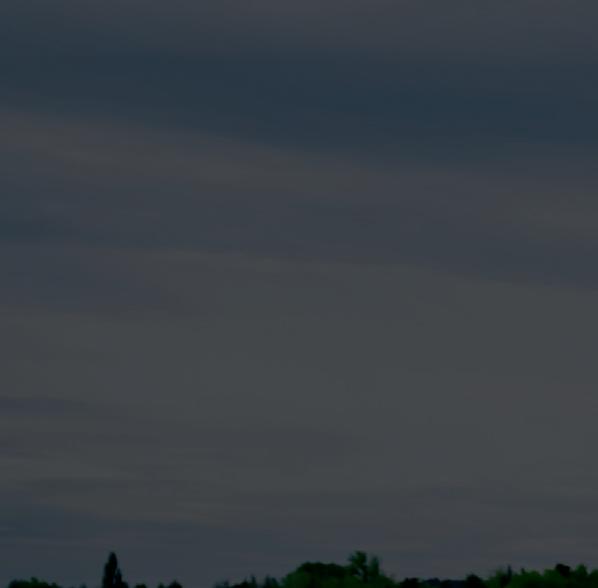
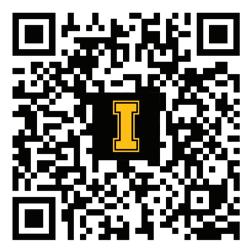




Moscow Affordable Housing Trust has worked with the City of Moscow, Latah County and private philanthropists to raise funds to subsidize the gap between the total project costs and the selling price of the house.





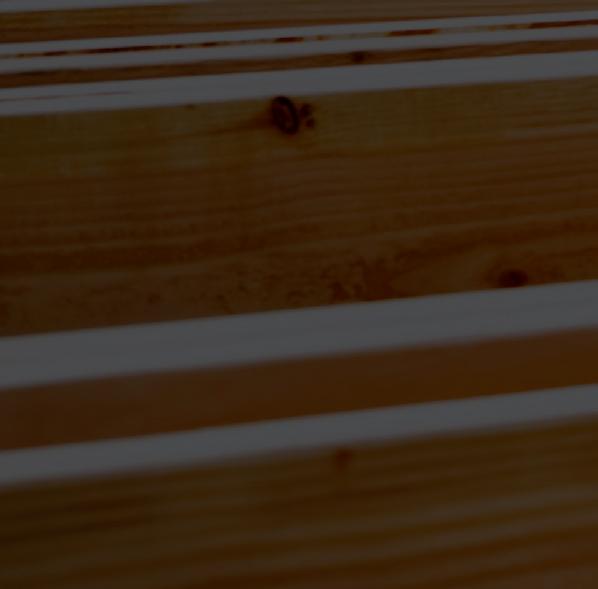

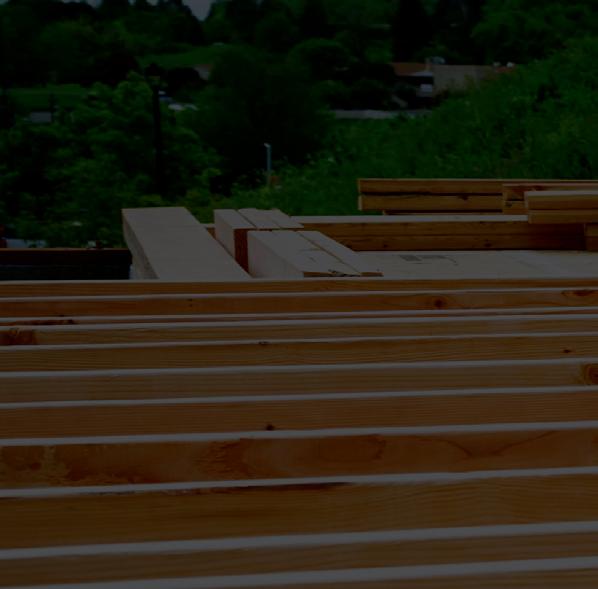














“Students not only designing the house but also building it is very valuable. When we can get architecture students in the field and have them build what they’ve designed, it makes them better architects.”

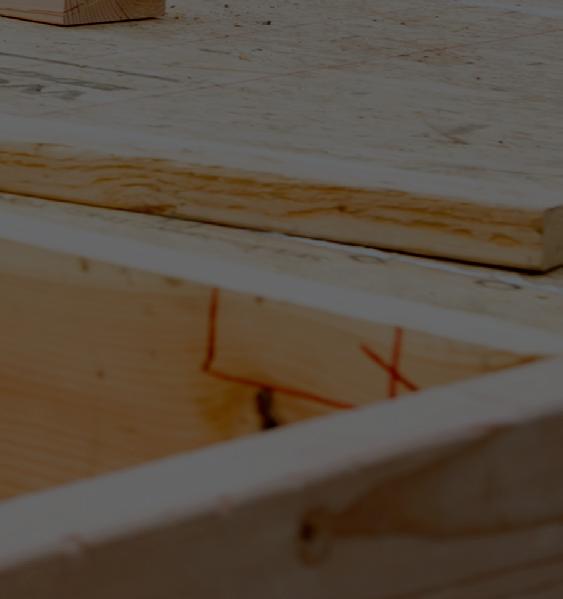







“Moscow has a lot of larger residential homes, a lot of rental houses and a lot of apartments. What you don’t see here are smaller houses for smaller families who want to live in a nice house with a price tag they can afford.”
“We got to do the schematic design work, then create the construction drawing and detailing, and now we actually get to build it. Building this house in the Moscow community, a place that I’ve called home for five years, makes it extra special.”
 — Mark Engberg ’84, principal of COLAB Architecture + Urban Design, of Portland, Oregon
— Brenna Church, a master’s of architecture student from Zillah, Washington
— Mark Engberg ’84, principal of COLAB Architecture + Urban Design, of Portland, Oregon
— Brenna Church, a master’s of architecture student from Zillah, Washington
Builders anticipate incorporating sustainable materials into future homes by taking advantage of advances in 3-D printing to create building materials out of wood waste and partnering with companies such as Jeromebased Hempitecture, which produces insulation products from hemp fiber.




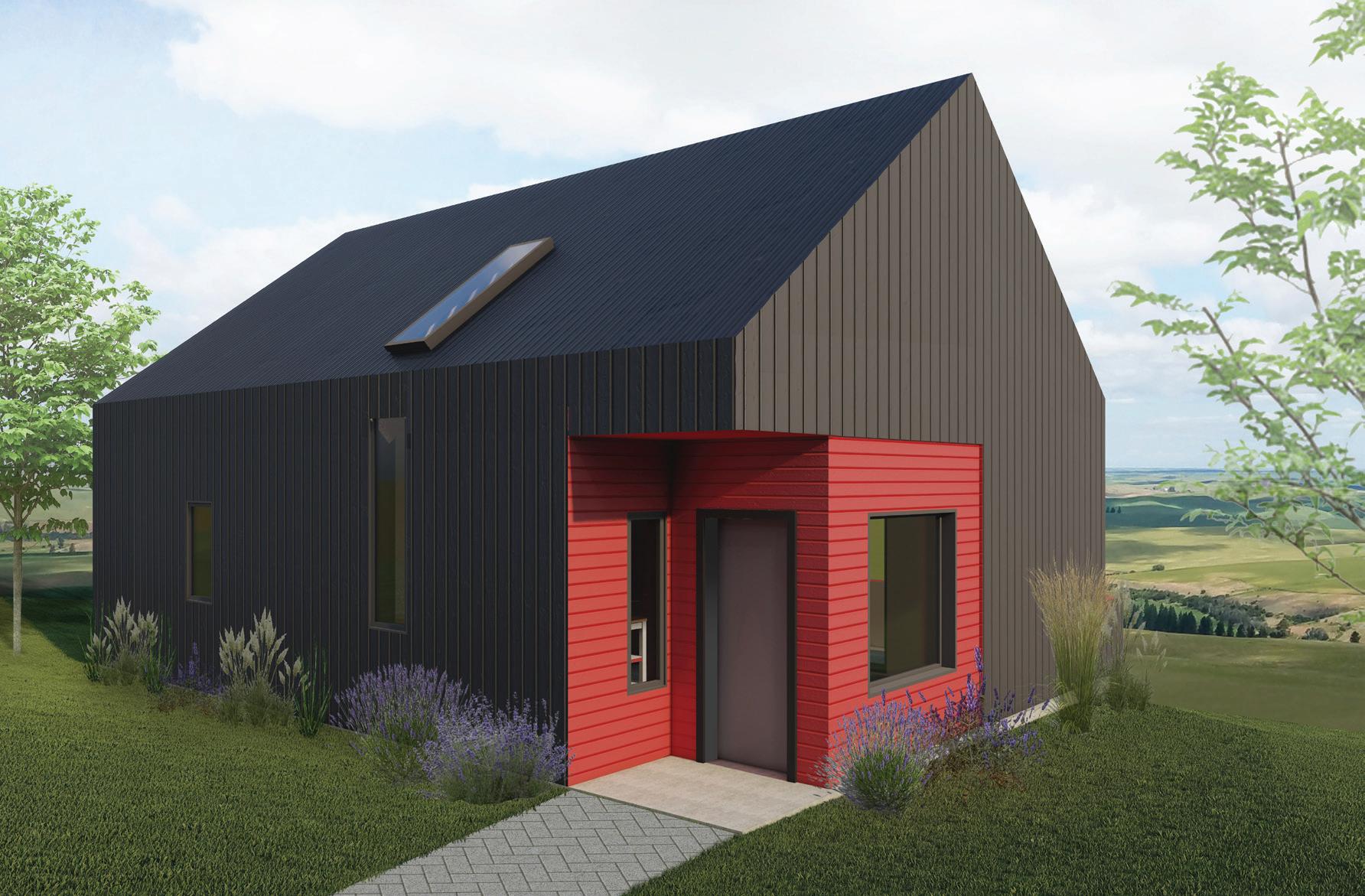
Although the homes are being built in Idaho, they will be constructed to Washington energy code requirements, meaning they will be energy efficient and will cost less to maintain.

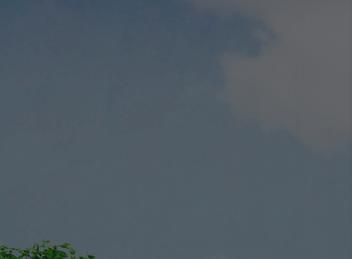





One home will be built by CAA graduate students each summer until 2027.


Through undergraduate research, Keera Paull ’22 helped scientists understand how microbes contribute to bee health. “Her results have practical application in helping honeybees,” Professor James “JT” Van Leuven said.




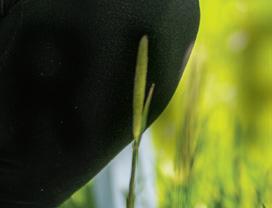

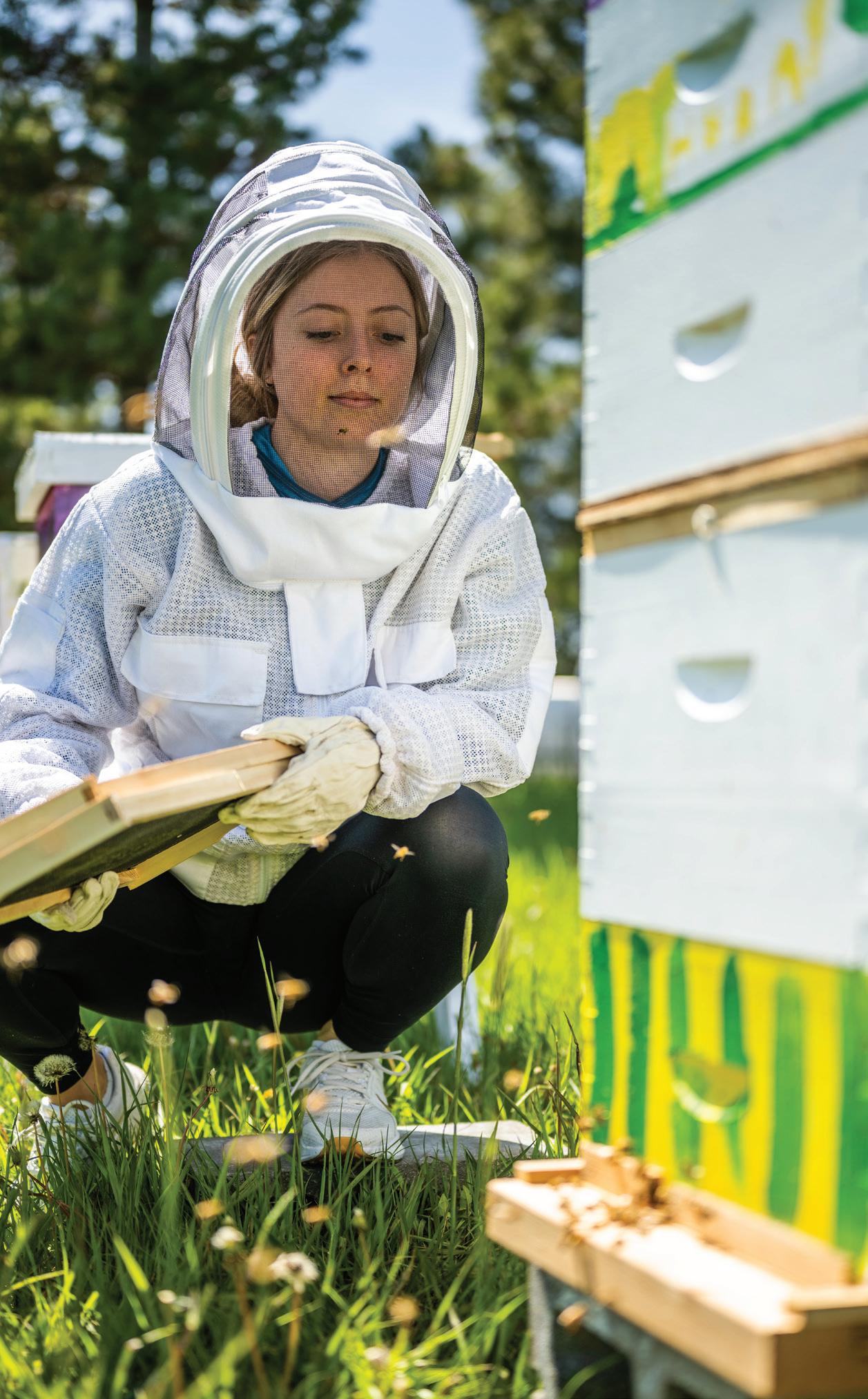
I did a lot of photography in 4-H and my favorite thing to take pictures of were insects, especially bees because they are pretty. I always focused my high school projects on bees and how to help them survive.
Coeur d’Alene
Activities for every future Vandal. Activities for every future Vandal.



Squirrel Maze
Help our Admin Lawn squirrel find the acorn!
Word Search











I Spy Game Find how many of each are in the puzzle!

_____ King Potato _____ I Tower _____ Kibbie Dome _____ Fish
Bear
Squirrel
Deer
Baked Potato
_____ Memorial Gym
_____ Administration Building
_____ Tractor-Trailer
_____ Skiers
_____ Sailboat _____ Double Trees _____ Wheat Stalk
Leda Kobziar didn’t expect her ecological studies to launch into the troposphere. The University of Idaho fire science professor hadn’t considered that publishing a paper on the spread of microbes in wildfire smoke would be a game changer in fire science circles.
Over the past couple of years however, Kobziar’s name has become synonymous with a new field of ecological research called pyroaerobiology. It is a name she coined to describe the study of living microorganisms found in plumes of forest fire smoke. Her work has appeared in national and international media and been published in several journals.
“The interest the smoke research has garnered has been crazy,” Kobziar said.
In collaboration with scientists at the University of Florida and Colorado School of Mines, Kobziar’s U of I team, which includes undergraduate, graduate, and postdoctoral students, explores the ecological and pathological repercussions of airborne bacteria and fungi hurled into the atmosphere during wildfires. Her group found more than a thousand different organisms surfing the smoke waves.
The idea that smoke could be a source of living microbes was first investigated almost 20 years ago, when a Texas father-daughter team, Forrest and Sarah Mims, published a paper in Atmospheric Environment that showed living fungal spores were present in the air when smoke from distant wildfires was present.
The Mimses sampled air collected using a kite flown over the Gulf Coast. They found bacteria and fungi in smoke from forest fires in Yucatán, Mexico.


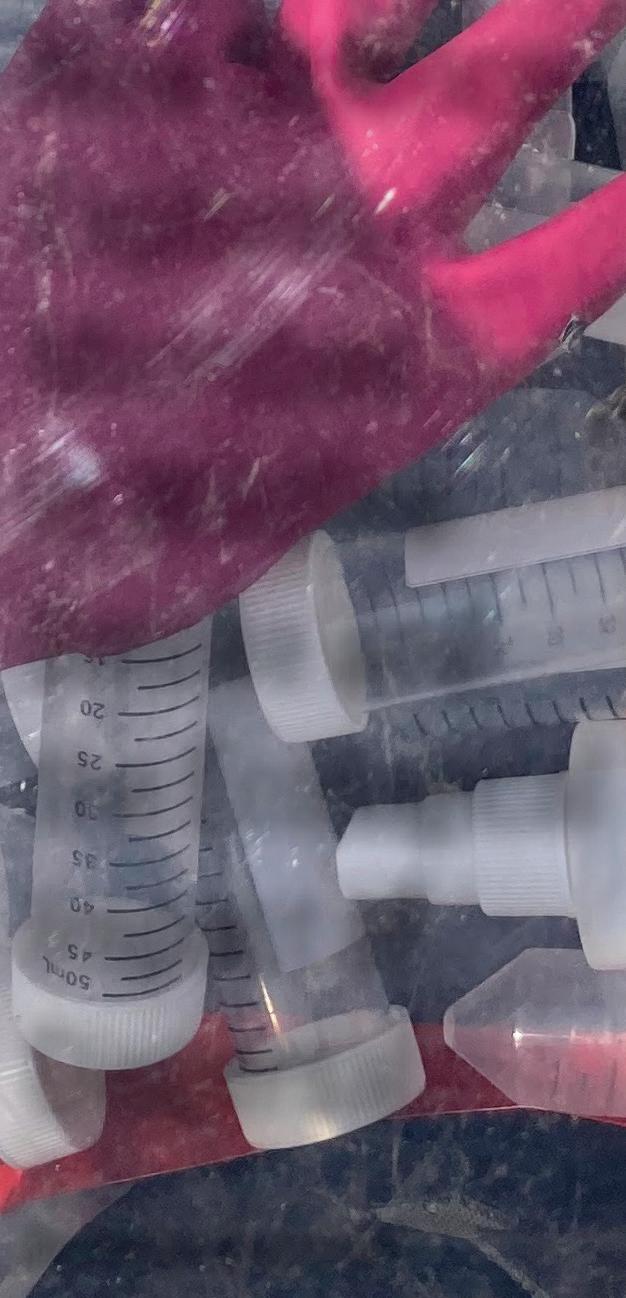
The Mims’ findings were not well publicized, and most scientists assumed smoke was too hot, gaseous and toxic to sustain microbes. Kobziar and fellow researchers developed new and more advanced methods to show, once again, bacteria and fungi can be transported in the volatile smoke of burning forests and grasslands. Because pyroaerobiology is so new, Kobziar’s team is constantly developing novel ways to collect microbes from smoke. Phinehas Lampman, a doctoral student, drone pilot and former firefighter who grew up in Headquarters, modifies drones using aluminum bar stock and 3D-printed carbon fiber to attach small pumps and tubes. The mechanisms suck wildfire smoke through filters where the airborne fungi and

bacteria can be collected.
“There aren’t any established ways to do any of this,” Lampman said. “We’re always coming up with new or better methods to conduct experiments, and that’s what makes it so interesting.”
The next step, said Kobziar, is to determine how long microorganisms can live in the smoke, how far they can travel, and what effects they can have on natural systems. “Are there repercussions for aquatic ecosystems from smoke transported over water bodies?”
Kobziar asked. “Does smoke transport pathogenic organisms that can affect crops, or is it transporting beneficial organisms critical for soil functioning?”
So far, Kobziar and colleagues discovered that about 80% of the microbes in smoke samples collected from burning forests in Florida were alive. Additional
samples collected with drones from extremely intense fires in the Rocky Mountain West found 78% of microbes were viable.
She estimates that 40 trillion to more than 100 trillion microbes are released into the atmosphere for every 2.5 acres burned in low- to mid-intensity fires, with over 350 quadrillion microbes emitted per 2.5 acres in higher intensity fires.

“This means that larger fires would be predicted to mobilize even larger numbers of microbes,” Kobziar said.
Microbes have been traveling in smoke for hundreds of millions of years, Kobziar said.
“Fire has been influencing the world in this way for many millennia, as a microbial volcano,” she said. “This changes how we think about fire’s role on earth, and its effect on atmospheric processes.”
She and her fellow researchers theorize that smoke may be a temporary refuge for microbiota.
“These are the things that our upcoming work is going to try to unravel and test,” she said. “There seem to be an infinite number of questions that remain to be answered.”

Fire has been influencing the world in this way for many millennia, as a microbial volcano. This changes how we think about fire’s role on earth, and its effect on atmospheric processes.
– Leda Kobziar




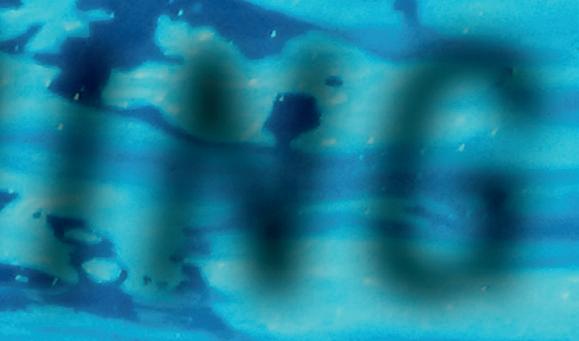


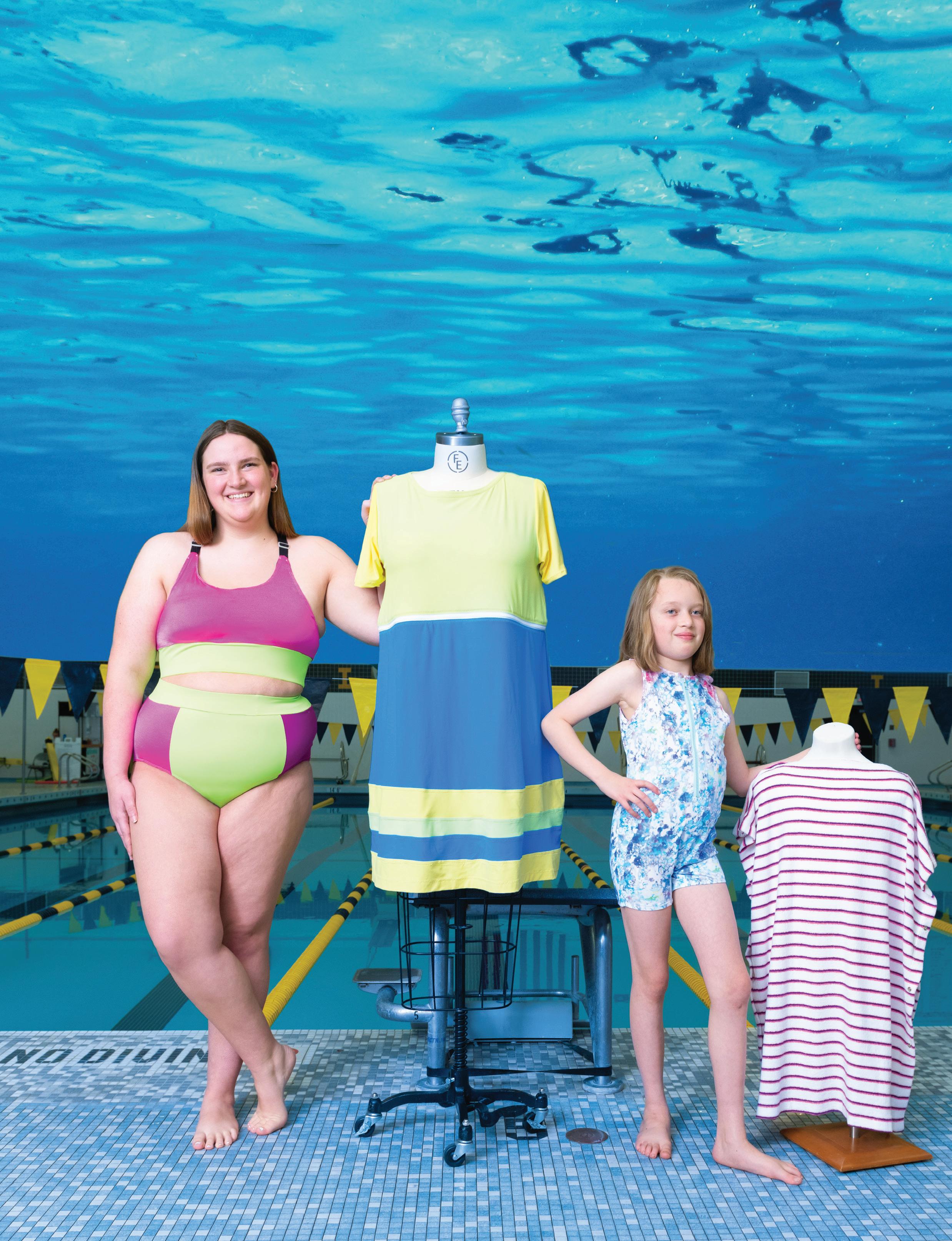 By Amy Calabretta ’03
By Amy Calabretta ’03
Six University of Idaho students recently found themselves presenting to one of the biggest brands in the world.
The apparel, textiles and design students created swimwear designs for Nike Swim –gaining real-world experience.

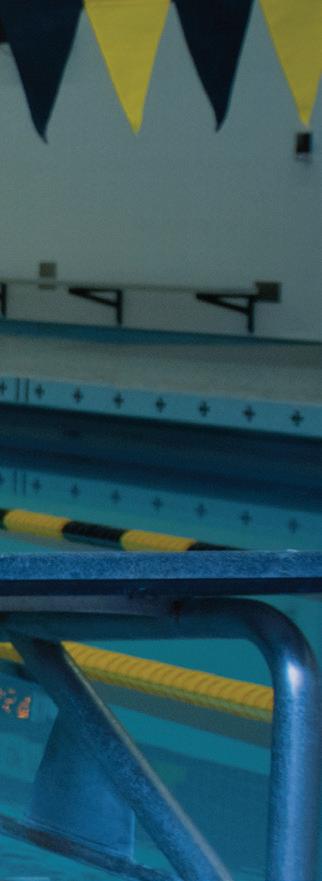
Lori Wahl, senior instructor in the Margaret Ritchie School of Family and Consumer Sciences, was contacted by Sumiko Kalish, Nike Swim design director, who asked if Wahl’s students would be interested in collaborating. Wahl jumped at the opportunity.

“The more students have the opportunity to work with a professional brief and expectations, the better prepared they are going to be for an interview, and ultimately a job,” Wahl said.







Kalish challenged the six students to identify an opportunity that Nike Swim wasn’t addressing and design a product to meet that need.
Working in teams, students researched Nike Swim’s strengths and weaknesses. They also incorporated Nike’s brand values into their designs, which focus on sustainability, engaging girls and women in sports, and inclusivity.
Olivia Chandler, Rachel Houle and Madison Machen – team Scintillate – identified a need for more style and color options for plus-size women. Daisy Blowers, Maggie Zee and Jaeda Schnuerle – team Sea & Shore – addressed the lack of paddle sport suits for young girls.
Students followed a typical design calendar, presenting concepts and designs to Wahl before a final design review with Kalish. They then moved into patternmaking, developing prototypes and finalizing fit.
Scintillate designed a two-piece suit with an adjustable top using recycled polyester. Strap adjustments were 3D printed using UV reactive filament that changes colors when exposed to UV rays.
Sea & Shore created a one-piece shortie swimsuit using high-stretch knit and a plant-based zipper. Velcro straps open over the shoulder, and the sides include extra seams that can be ripped out to extend the size to grow with the customer.
The teams also designed complementary deck wear using performance cotton. Scintillate used a fabric treated with Wicking Windows by Cotton, Inc. The skin-facing side of the fabric includes a printed pattern that distributes moisture for evaporation. The team flipped the fabric, putting the pattern on the outside to hide wet areas caused by a damp swimsuit.

Sea & Shore created a zero-waste cover-up made from terry cloth with snaps made from plants and recycled bottles. The snaps allow the cover-up to be adjusted to grow with the customer. When unsnapped, it can be used as a towel.
“Working with up-and-coming designers to see through fresh eyes opportunities for our Nike Swim consumer was really exciting,” Kalish said. “Their research was thorough and showed areas for design opportunities within sustainability, extended sizes and versatile swim.”
The project culminated with a trip to Portland, Oregon, to present final prototypes to Kalish and her team.
“The students showed up at the Nike Swim office prepared and ready to show their designs,” Kalish said. “Their digital presentations, inspiration boards and design creations came to life on our mannequins and really inspired our team.”
The project offered students the opportunity to see what the design process would look like in an industry setting.
“This is the process you’re doing when you are working professionally,” Wahl said. “And the fact that we partnered with a professional company — and not just any company but an internationallyknown company — was a big confidence boost for the students.”

It’s one thing to talk about all the things that are wrong with the system. It’s another to talk about what to do in the future. My mentors at U of I asked me to think about solutions and putting the implications of research into action.Grace Meyer ’22 worked on a research team collecting demographics on people accused of terrorism.
When administrators in Idaho’s largest school district realized they needed more candidates for leadership positions – and quickly – they didn’t panic. The West Ada School District leaned into its partnership with University of Idaho’s College of Education, Health and Human Sciences to restock its shelves.
U of I began creating cohorts for Idaho school districts in 2007, training groups of teachers how to become better candidates for leadership positions, such as principals and superintendents. The university is running a principal cohort in West Ada and launched a similar cohort this fall for Region 1 school districts in the Idaho Panhandle.
The West Ada Principal Cohort classes began in fall 2021, which means the district should have more than 20 new principal candidates by summer 2023. The timing is perfect, according to Marcus Myers, the district’s chief academic officer.
“We hired 49 building administrators last year and we need more candidates,” he said. “We need to be more intentional about developing our people into those leadership positions faster.”

The cohort is a two-year graduate program in Educational Leadership that prepares teachers and other qualified participants to become principals at K-12 public schools. The classes combine a mixture of in-person and virtual learning and take place after business hours, as most of the participants are teachers working day jobs in the district. According to Myers, developing teachers already in the district for leadership positions helps them even before they graduate. Learning the ins and outs of district leadership, they start to understand the bigger picture.
Michelle Weitz, the West Ada Cohort coordinator, worked at U of I for over 30 years before retiring in 2020. She was coaxed out of retirement to run the cohort out of the University of Idaho Boise office because of her involvement with cohorts U of I produced for the same school district — then called Meridian School District — between 2010 and 2013.
“I was one of the only ones around who knew how to do it,” Weitz said, with a laugh.
The West Ada School District serves nearly 40,000 students. District officials hope the current principal cohort will provide relief for their immediate staffing needs. Looking ahead, West Ada predicts eight new schools will need to be built over the next decade to keep up with population growth. Collaborations with U of I on future cohorts appear imminent.
“Five years down the road, I could see us needing to do this three more times,” said Myers ’08, ’20, who holds two degrees from U of I in educational leadership – principal and education specialist-superintendent.
Elizabeth Wargo, assistant professor of education at University of Idaho Coeur d’Alene, is paying close attention to the success of the Treasure Valley principal cohorts. She said that when the population grows exponentially, there can never be too many candidates for leadership positions in public schools.

“You want to have a deep bench,” she said. “You need to have a backup for your backup.”
Wargo and U of I Coeur d’Alene are establishing a cohort modeled after West Ada’s for Idaho’s Region 1 K-12 schools, which includes Benewah, Bonner, Boundary, Kootenai and Shoshone counties.
North Idaho counties, particularly Kootenai County, experienced heavy population growth over the past several years. The expansion and resulting strain on public schools led several Region 1 schools to reach out to Wargo to ask how U of I could help. As a result, the Region 1 Principal Cohort was created.
“It’s our obligation as a land-grant university to help our schools in the Panhandle thrive,” she said.
Wargo said the hybrid system of in-person and virtual learning is a good model for North Idaho schools. Unlike the urban landscape of the BoiseMeridian-Nampa area, schools in Idaho’s Region 1 are much more spread out, and employees often face difficulties with travel during the winter months.
As the state’s population increases, U of I plays a crucial role in responding quickly to the needs of growing public schools, according to Myers, Weitz and Wargo. By partnering with U of I for cohorts, school districts like West Ada know they are getting real-time solutions to staffing needs so they can focus on educating Idaho’s children.
“We’re very proud of our partnership with U of I and I hope it never goes away,” Myers said. “It’s not just about what we are doing at West Ada. It’s about helping all of Idaho.”
It’s our obligation as a land-grant university to help our schools in the Panhandle thrive.
– Elizabeth Wargo
Diversity is the hallmark of a recent $10 million grant from the USDA National Institute of Food and Agriculture to build sustainability and prosperity for the dairy industry in Idaho and beyond.
The 20 graduate students and postdoctoral researchers working with faculty on this grant come from many regions, countries, disciplines and backgrounds.

The theme of diversity aptly encompasses their research. The team of agronomists, economists, animal scientists, engineers and soil and water experts is addressing a common yet critical challenge – transforming one person’s waste into another person’s treasure. The five-year project is titled “Creating a New Bioeconomy for Dairies to Increase Nutrient Recycling, Enhance Productivity of Crops and Stimulate Prosperity in Rural America.”
The group is developing management practices, processes and technologies to produce bioproducts like fertilizer substitutes and bioplastics on a large scale from dairy waste streams. They’re also evaluating economic returns, environmental benefits and the perceived value to consumers and dairy producers of bioproducts.
It wasn’t a conscious choice to field such a diverse research team. Instead, it reflects the general diversity among U of I graduate students, said Mark McGuire, the grant’s principal investigator, College of Agricultural and Life Sciences associate dean of research and director of the Idaho Agricultural Experiment Station.
He believes the group’s diversity will be a key to its success. McGuire noted participants from countries such as Armenia, Bangladesh, China and Ghana approach problem-solving and product commercialization through different lenses.
“It really behooves us to have people from different perspectives, particularly in the sociological piece. We’re trying to reach different groups of people,” McGuire said.

The benefit such diversity provides is also perceived by the graduate students.

“The first impression of that group of students is their background is so diverse, and I get to talk with people from different backgrounds, which gives me fresh ideas,” said Zhengliang “Lucas” Yang, of China’s Szechuan Province.
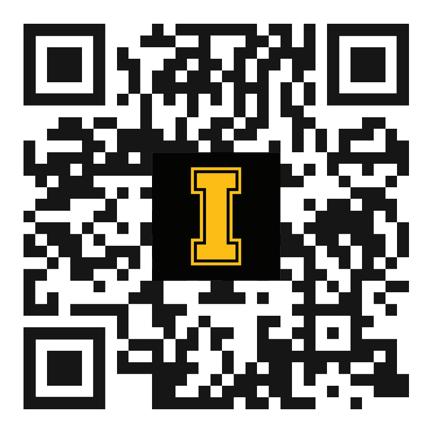
Yang, who started work on a doctorate this fall, wrote a paper on the willingness of consumers to pay for bioplastics made from manure, along with other considerations about the technology.
“At least from the perspective of economics, I think biodegradable plastics will definitely improve the living quality and help us save more money, be friendly to the environment and make the world a better place,” Yang said.
Emmanuella Owusu Ansah, a master’s student in plant sciences from Ghana, helped evaluate the nitrogen response of spring barley and wheat for the project.
The Idaho Center for Agriculture, Food and the Environment will include a 2,000-cow research dairy in Rupert, which will be the largest in the nation, to help dairymen maintain sustainable operations in the face of mounting resource pressures. The project will also include a 1,200-acre Water and Soil Health Demonstration Farm, where research will assess connections between crop and animal agriculture.





“I like the fact that we are trying to help the agricultural sector with sustainability and the environment in mind,” Ansah said.
Dairy waste is voluminous and costly to transport. Environmental challenges may result if agricultural lands where it’s applied become oversaturated with nutrients. Maggi Laan, of Weiser, is involved in research using biochar – a lightweight residue made of carbon and ashes – to absorb phosphorus from dairy lagoons. The process separates nutrients into a more easily transportable form, which can be used as a fertilizer substitute.
“It’s really nice to get all of those other perspectives instead of just people in Idaho working on this project that’s based in Idaho,” Laan said.
While getting to know the other students on the project, Laan discovered participants’ appreciation for science was a unifying factor — team members from different backgrounds who shared a common scientific discipline were most surprised by how much they had in common.
James Schoepflin ’64 recently published his memoir/autobiography “My Flight.” It is available online through Auntie’s Bookstore in Spokane, Washington.
Harvey Waldron III ’67 retired after 48 years at Boeing. He also worked at GE. Waldron is enjoying retirement as a flight instructor.
James Griffith ’67, ’79 received the Ultrasound Pioneer Award for work in medical imaging using ultrasound. He worked with several organizations during his engineering career and is now enjoying retirement in Phoenix, Arizona.
Julia Anderson ’68 published the 2022 edition of her book “Smart Women Smart Money Smart Life: Take Charge Now to Have the Future You Deserve.”
Daniel Stephen Looney ’68 received the U of I Alumni Association Silver and Gold Award, Idaho Governor’s Award for Excellence in the Arts and the Marquis Who’s Who Lifetime Achievement Award.
Art Bettge ’76 was elected mayor of Moscow in November 2021.
Nancy Mahoney ’76 was presented the Women of Achievement Award for Business and Industry by the Spokane YWCA for her decades of serving as a role model for women.
Santiago (Ago) Ramos ’77 retired from the Gallup Independent newspaper in Gallup, New Mexico, after 40 years as a sportswriter. Ramos won first place for sports writing for Class 1 daily newspapers in the New Mexico Press Association-Associated Press Managing Editors contest and worked for the Grants Beacon early in his career.
Scott Fehrenbacher ’80 was chosen to serve as chief executive officer for Habitat for Humanity in Vancouver, British Columbia.
Pat Shields ’80 retired from the Alaska Department of Fish and Game as a fishery biologist after more than 37 years.
Mark Watts ’81 retired from the Bechtel Corporation after 37 years. He also retired from executive level positions at both the Los Alamos and Lawrence Livermore national laboratories. He and his wife Kelly (Webster) ’81 retired in North Idaho.
Sheila Borchert ’82 retired after 20 years at BMW of North America as customer relations manager.
Dean Hubbs ’82 retired after 15 years as a vice president with SAIC, four years at FBI headquarters, and 22 years as a U.S. Marine Corps officer. He now works independently as a Charleston, South Carolina, area industry consultant.
Robert Clark ’83 retired in 2022 after 38 years as a defense contractor and scientist for Department of Navy.
Col. Richard W. Dean II ’83 retired after 30 years of federal service, culminating as director of engineering for the National Defense University. Dean was a construction management agent for the addition of a Wall of Remembrance and renovation of the Korean War Veterans Memorial on the National Mall in Washington, D.C.
Scott Macduff ’85 was promoted to director of human resources for Ameriflight, a nationwide cargo airline.
Travis Jones ’99, ’02 joined the Boise office of Strategies 360 as vice president of government relations.
Gina Hulsizer Strobel ’01, ’02 recently became an owner in an accounting firm in Coeur d’Alene.
Walter Wilson ’02 retired from 41 years of federal service with the U.S. Navy as a marine biologist. He worked for the National Marine Fisheries Service after receiving his degrees in wildlife and fisheries management from U of I in 2002. Prior to his time at U of I, he served an activeduty career in the U.S. Navy.
Thad Berrett ’04 recently became the Powder River district ranger on the Bighorn North Fork in Wyoming.
Alison Weigley ’05 was promoted to director of external relations for Pullman Regional Hospital for more than 50 entities that encompass hospital departments, hospital-owned clinics and the foundation. She also serves as a major gift officer.
Jerrod Warner ’08 recently joined the Brundage Mountain Team in McCall as director of projects.
Susie Skavdahl ’10 completed 11 years designing and instructing a course in Educational Technology for Washington State University.
Janice Jordan ’11 was named CEO of Marimn Health Center in Plummer. Prior to her advancement, she was in medical operations and chief clinical officer.
Jessica Deno ’15 to Abigail Overfelt ’15 on April 3, 2021.
U of I extends its condolences to the family and friends of our departed Vandals.
Forrest E. Sears, Moscow, Jan. 26, 2022
James M. Cassetto ’72, Lewiston, Feb. 22, 2022
James L. “Jim” Murphy, Moscow, April 3, 2022
Harold C. Gibson Jr. ’75, April 29, 2022
Dale Goble, Moscow, April 14, 2022
Paul L. Blanton ’52, Spokane, WA, May 22, 2022
Leon Neuenschwander, Pueblo, CO, June 1, 2022
Cecelia E. Luschnig, Moscow, June 15, 222
Edmund M. Chavez, Moscow, July 23, 2022
Richard A. “Dick” Johnston ’53, Moscow, Aug. 8, 2022

The Vandal Family is BRAVE.
We are BOLD. And together we are building an UNSTOPPABLE future for students, for Idaho, for the world.

Learn how you can be UNSTOPPABLE. uidaho.edu/unstoppable
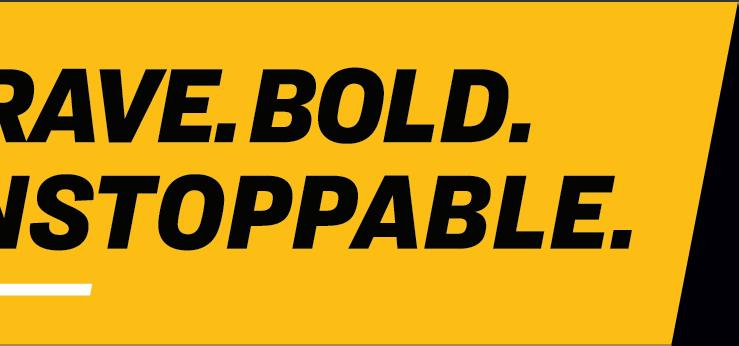





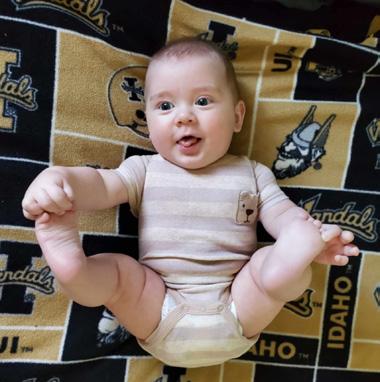
Class Notes for these Brave and Bold kiddos were submitted between
1. Aspen Grace Bennett, child of Cheynce and Tessa (Waterman) Bennett ’08


2. Jasi Lynn Cada, daughter of Brenna (Kindall) Cada ’20
3. Hugo Joseph Eschen, son of Casie and Stephen Eschen ’11, grandson of Sue (Watts) ’78, ’85 and Dave Eschen ’78, ’87, great-grandson of Arlene (Deobald) ’43 and Joseph Watts ’40

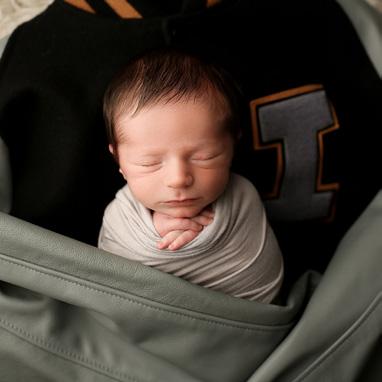

4. Jane Ewing, daughter of Cara ’08 and Justin Ewing ’09
5. Olivia Ann Martin, daughter of Lauren Feeney ’05 and Michael Martin

6. Drew De La Torre-Hogan, son of Samantha De La Torre-Hogan ’20
7. Annie Paige Judd, daughter of David Judd ’05 and Brynn Knudson ’08, ’18
8. Henry Lawrence and Penelope Jane Liddicoat, twins of Tiffany (Sharples) Liddicoat ’14
9. Quinn Blair Lucas, daughter of Marcus and Chloe Lucas ’16, granddaughter of Kevin Roach ’85
10. Jay Edward Moss, son of Mark Moss ’04
11. Patrick Scott Norby, son of Michael Shea (O’Donnell) ’14 and Michael Norby ’13
12. Blair Ruth Obermeyer, daughter of Ami (Larson) ’08 and Andrew Obermeyer ’08
13. Alice Josephine Olsen, daughter of Donald C. Olsen ’22
14. Wilson Anthony Parrott, son of Samantha (Perez) ’12, ’19 and Stephen Parrott ’12

15. Ila Peterson, daughter of Kellsie (Hodges) ’16 and John Peterson ’15, granddaughter of Rick Hodges ’85
16. Twins Parker and Reese Wells, sons of Allison (Renfrow) ’12 and Mike Wells ’17


17. William Blaize Silvestri V, son of Billy and Allison M. (Wagner) Silvestri ’15
18. Aliyah Small, daughter of Hollie (Garrison) ’13 and Kevin Small ’12
1. 3. 4. 6. 7. 9. 8. 10. 12. 11. 15. 14. 16. 18. 17.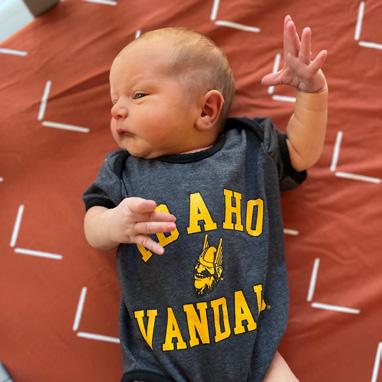




19. Taysom Neil Tiegs, child of Nathaniel and Sara Tiegs ’05
20. Charlotte Uhrich (center), daughter of Kara (Riordan) ’10 and Bret Uhrich ’09 (siblings Elizabeth, right and Weston, left)
21. Maggie Patricia Waybright, daughter of Jamie Ann (Thomas) ’11 and Christopher Ryle Waybright ’11
22. Woodford Thomas South, son of Carly (Wood) ’07 and Greg South ’08
23. Diego Rosas, son of Carolina Zamora ’14 and Paul Rosas

24. Sasha Wren Cox, daughter of Holly (Diehl) ’10 and Chris Cox ’09, ’13

25. Vincent Asa Horton, son of Samuel Horton ’14 and Kristin (Burkhalter) Horton
26. Hudson Richard Reilly, son of Spencer ’13 and Rebecca (Durasco) Reilly ’12


27. Wes (b. 2017), Wiley (b. 2019) and Holly (b. 2021) Wagner, children of Heidi (Lyons) Wagner ’12

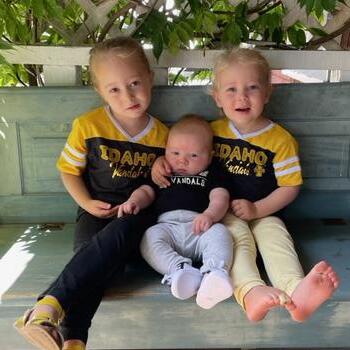
28. Emmett Graham Ruffridge, son of Hannah and Ryan Ruffridge ’13


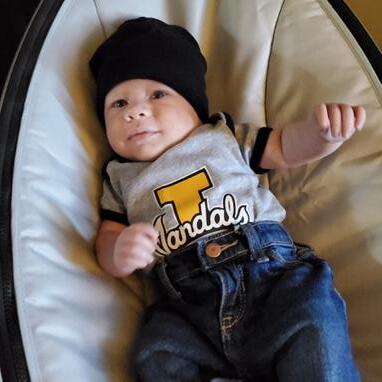
29. Layne Hotchkiss, daughter of Jessica ’13 and Colton Hotchkiss ’17
30. Daniel and Elizabeth Schwartz, children of Rebecca Schwartz ’06
31. Maesie Christine Blades, daughter of Kayla and Jarod Blades ’01
32. Madeline Ann Cuddihy, daughter of Jeremy ’12, ’14 and Bridget (Wimer) Cuddihy ’12, ’14
33. Natalie Harper Andrews, daughter of Stephanie and Michael Andrews ’12

34. Riley Michael Paul, child of Ryan ’17 and Madison “Maddy” Paul ’18
35. Caden Allen Parker, son of Sydney and Caleb Parker ’16
Help transform lives and find sustainable solutions to the world’s toughest problems.
www.uidaho.edu/unstoppable